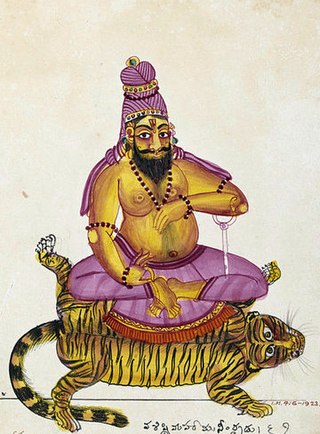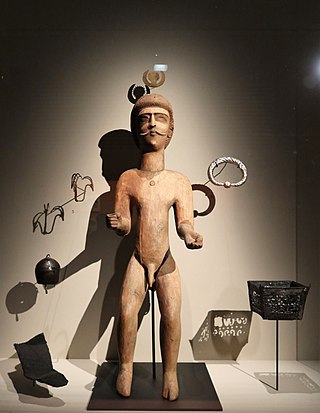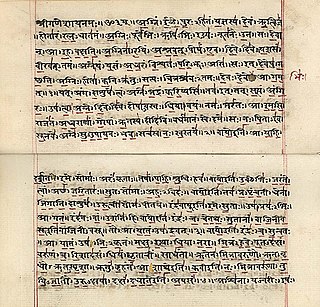
Aditi is an important Vedic goddess in Hinduism.

Atri or Attri is a Vedic sage, who is credited with composing numerous hymns to Agni, Indra, and other Vedic deities of Hinduism. Atri is one of the Saptarishi in the Hindu tradition, and the one most mentioned in its scripture Rigveda.

Vishvamitra is one of the most venerated rishis or sages of ancient India. Vishvamitra is one of the seven Brahmarshi. According to Hindu tradition, he is stated to have written most of the Mandala 3 of the Rigveda, including the Gayatri Mantra (3.62.10). The Puranas mention that only 24 rishis since antiquity have understood the whole meaning of —and thus wielded the whole power of — the Gayatri Mantra. Vishvamitra is supposed to have been the first, and Yajnavalkya the last.
Saṃhitā literally means "put together, joined, union", a "collection", and "a methodically, rule-based combination of text or verses". Saṃhitā also refers to the most ancient layer of text in the Vedas, consisting of mantras, hymns, prayers, litanies and benedictions.

The Vedas are a large body of religious texts originating in ancient India. Composed in Vedic Sanskrit, the texts constitute the oldest layer of Sanskrit literature and the oldest scriptures of Hinduism.
Samudra is a Sanskrit term literally meaning the "gathering together of waters". It refers to an ocean, sea or confluence. It also forms the name of Samudradeva, the Hindu god of the ocean. The word is also present on other languages influenced by Sanskrit.
The first Mandala ("book") of the Rigveda has 191 suktas which has 2006 hymns. Together with Mandala 10, it forms the latest part of the Rigveda. Its composition likely dates to the late Vedic period or the Early Iron Age.
The second Mandala of the Rigveda has 43 hymns, mainly to Agni and Indra chiefly attributed to the Rishi gṛtsamada śaunohotra. It is one of the "family books", the oldest core of the Rigveda, which were composed in early vedic period.
The third Mandala of the Rigveda has 62 hymns, mainly to Agni and Indra. It is one of the "family books", the oldest core of the Rigveda, which were composed in early Vedic period. Most hymns in this book are attributed to viśvāmitra gāthinaḥ
The fourth Mandala of the Rigveda has 58 hymns, mainly to Agni and Indra. It is one of the "family books", the oldest core of the Rigveda, which were composed in early vedic period(1500-1000 BCE).
The fifth Mandala of the Rigveda has 87 hymns. Most hymns in this book are attributed to the Atri family. The mandala is one of the "family books", the oldest core of the Rigveda, which were composed in early vedic period(1500-1000 BCE).
The sixth Mandala of the Rigveda has 75 hymns, mainly to Agni and Indra. Most hymns in this book are attributed to the bārhaspatya family of Angirasas, especially to Bharadvaja. It is one of the "family books", the oldest core of the Rigveda, which were composed in early vedic period(1500-1000 BCE).

Vasishtha is one of the oldest and revered Vedic rishis or sages, and one of the Saptarishis. Vasishtha is credited as the chief author of Mandala 7 of the Rigveda. Vasishtha and his family are mentioned in Rigvedic verse 10.167.4, other Rigvedic mandalas and in many Vedic texts. His ideas have been influential and he was called the first sage of the Vedanta school of Hindu philosophy by Adi Shankara.
Rigvedic deities are deities mentioned in the sacred texts of Rigveda, the principal text of the historical Vedic religion of the Vedic period.

Mitra is a Hindu god and generally one of the Adityas, though his role has changed over time. In the Mitanni inscription, Mitra is invoked as one of the protectors of treaties. In the Rigveda, Mitra appears primarily in the dvandva compound Mitra-Varuna, which has essentially the same attributes as the god Varuna alone, e.g. as the principal guardian of ṛtá "Truth, Order". In the late Vedic texts and the Brahmanas, Mitra is increasingly associated with the light of dawn and the morning sun. In the post-Vedic texts – in which Mitra practically disappears – Mitra evolved into the patron divinity of friendship, and because he is "friend", abhors all violence, even when sacred.
The Battle of the Ten Kings first alluded to in the 7th Mandala of the Rigveda (RV), took place between a king of the Bharatas and a confederation of tribes. It resulted in a decisive victory for the Bharatas and subsequent formation of the Kuru polity. The Battle of the Ten Kings, mentioned in the Rigveda may have "formed the 'nucleus' of story" of the Kurukshetra War in the Mahabharata.

The Bharatas were an early Vedic tribe that existed in the latter half of the second millennium B.C.E.

In Hinduism, Adityas, refers to the offspring of Aditi, the goddess representing the infinity. The name Aditya, in the singular, is taken to refer to the sun god Surya. Generally, Adityas are twelve in number and consists of Vivasvan (Surya), Aryaman, Tvashta, Savitr, Bhaga, Dhata, Mitra, Varuna, Amsa, Pushan, Indra and Vishnu.

The Rigveda or Rig Veda is an ancient Indian collection of Vedic Sanskrit hymns (sūktas). It is one of the four sacred canonical Hindu texts (śruti) known as the Vedas. Only one Shakha of the many survive today, namely the Śakalya Shakha. Much of the contents contained in the remaining Shakhas are now lost or are not available in the public forum.








